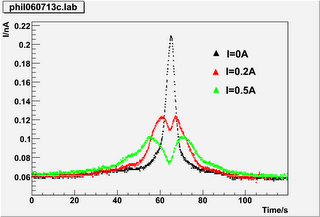If you look at this plot then the maximum value (0.21) is nearly four times larger than the minimum value (0.06). This means that the signal is almost three times as large as the background: so this is more of a lamppost in a flower arrangement than a needle in a haystack (if you are a layman) or a signal/background ratio of 3:1 (if you are a physicist).
This background of 0.06 nA doesn't come from the beam and is always present, so in principle you could just subtract this value from all the measurements to see how many atoms come from the beam (this is then your signal). The trouble is that the 0.06 is sometimes 0.058 and sometimes 0.062, and these fluctuations cause the measurement to jump up and down from point to point. The only way to get a really nice measurement is to keep this background very low. This is where the liquid nitrogen cold-trap comes in handy: the more stuff which freezes on to this trap, the less background is seen by the detector, and the smoother your curves are.

1 comment:
Nice plot, congratulations! And it seems that - compared to the last plot - you have a finer resolution for your current measurement, too!
Post a Comment